Curriculum vitae structure - guide, tips & templates
The Curriculum Vitae is an essential part of your application and comes in third place after the cover letter and the application letter. The German CV is comparable to an international CV but has some differences. In Germany, the application culture has specific rules and standards. To find a job faster and more successfully, it is worth investing a few hours to learn how to create a first-class application document.
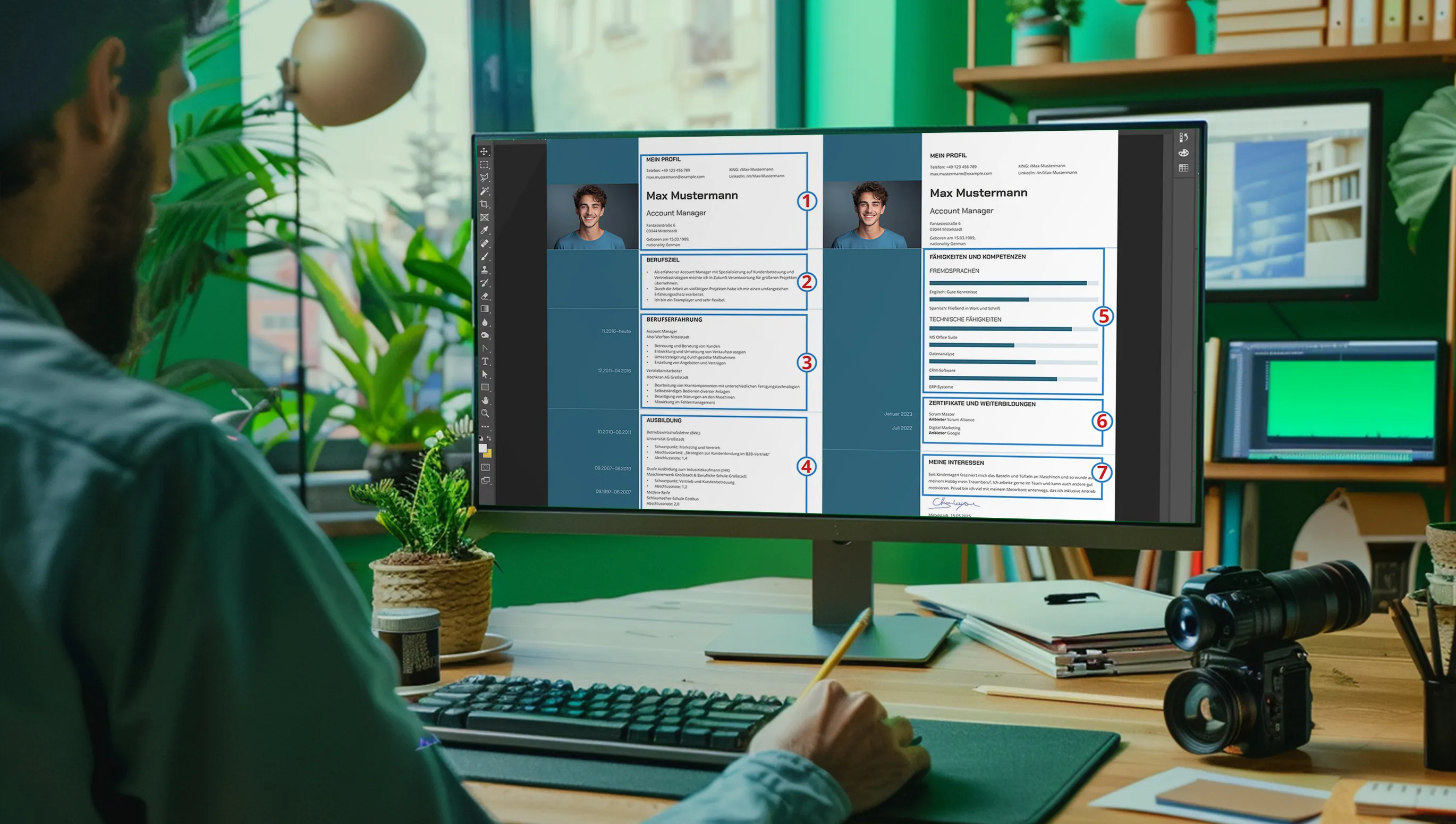
A CV should reflect your professional career, document your professional progress, and show that you do not change jobs every year. Also important are the relevant qualifications and work experience for the advertised position.
Creating a first-class application document is not easy. But after reading this article, it will become easier for you. Here I explain the structure of a CV and provide you with tips and examples for formatting.
The price of success is dedication, hard work, and an unremitting devotion to the things you want to see happen.
Frank Lloyd Wright
Table of Contents
CV Structure
In this article, we won't waste a thousand words, let's get straight to the point. Below is an image of the classic structure of a CV. There are both classic and modern CV templates available, depending on the position, but the basic structure remains the same. The difference lies only in the design. Do you know why? Because it's the standard.
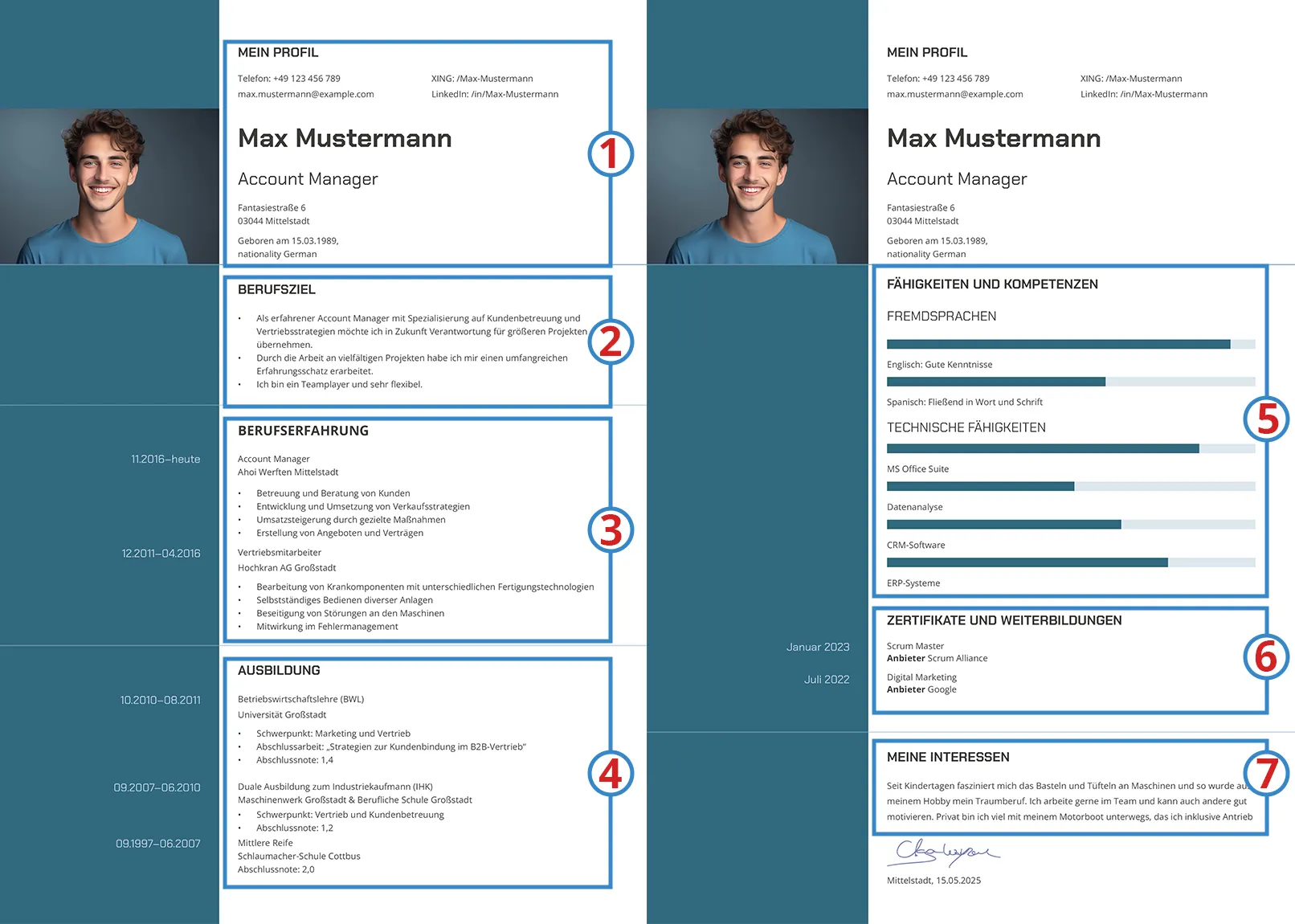
- Contact Information
- Career Objective
- Work Experience
- Education
- Skills and Competencies
- Certificates and Further Education
- Hobbies and Interests
The Classic Structure
The structure of a CV is a very interesting but extensive topic. We have prepared articles with examples for filling in the various sections. There we discuss what should be written when filling out the CV and what should not. Additionally, there are useful tips and common mistakes. Click on the links to learn more.
Contact Information (Personal Details in the CV)
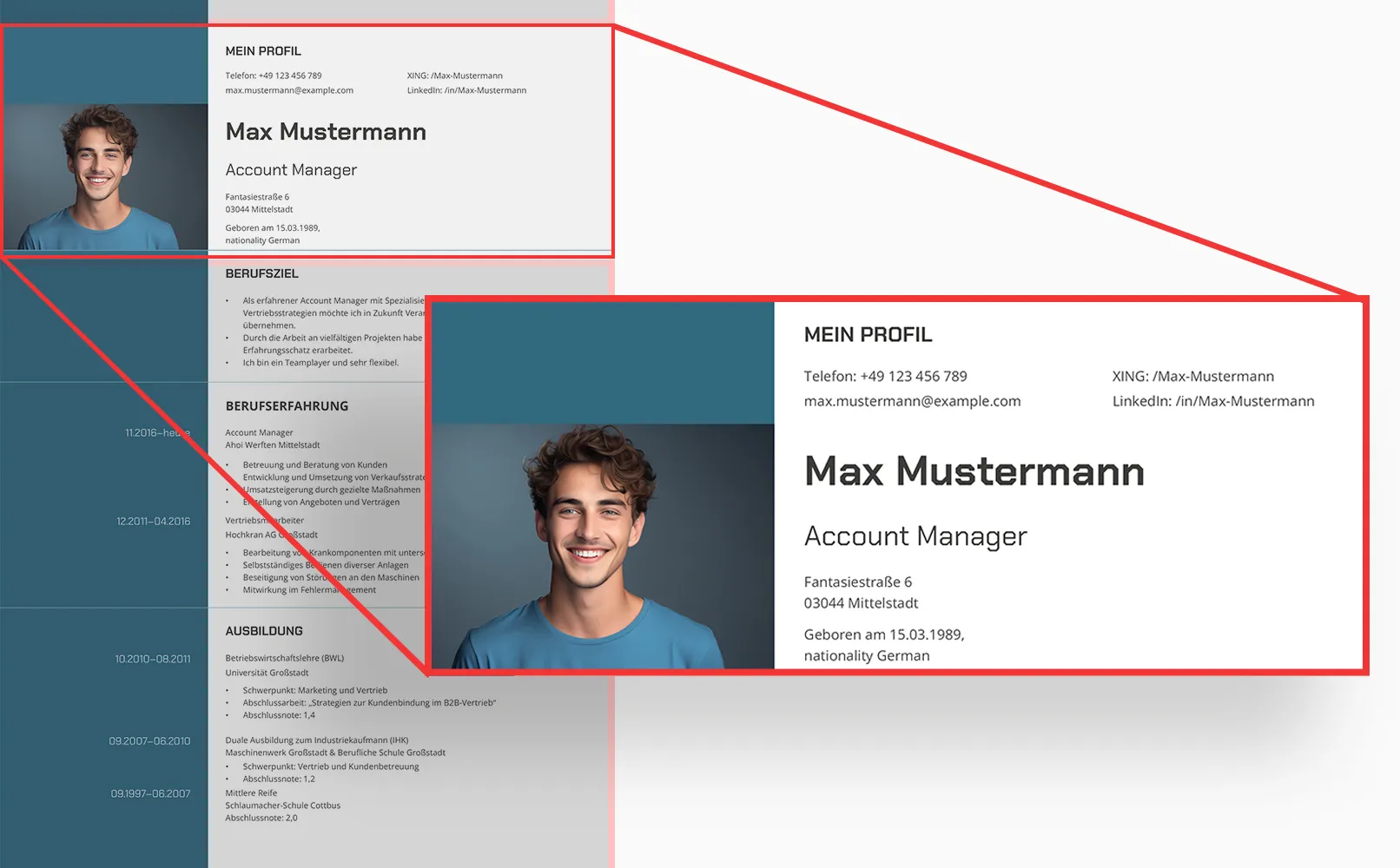
Provide your full name, address, telephone number, and email address. Ensure that the email address appears professional (no nicknames or inappropriate terms). Optionally, you can also include a link to your LinkedIn profile.
Filling out a template is always more convenient than writing a CV from scratch. Our templates provide structure and formatting that make the process of creating a professional document easier. This saves time and effort, allowing you to focus on content. A properly filled template helps avoid common mistakes and makes your CV more appealing to employers. Click on our templates to make your life easier, save time, and find a job faster. Ready-made samples are a great way to create a quality CV without unnecessary hassle.
Career Objective
In one or two sentences, state your career objective. Describe the position you are aiming for and how it fits into your career plan. Avoid general statements, be specific and goal-oriented.
Work Experience in the CV
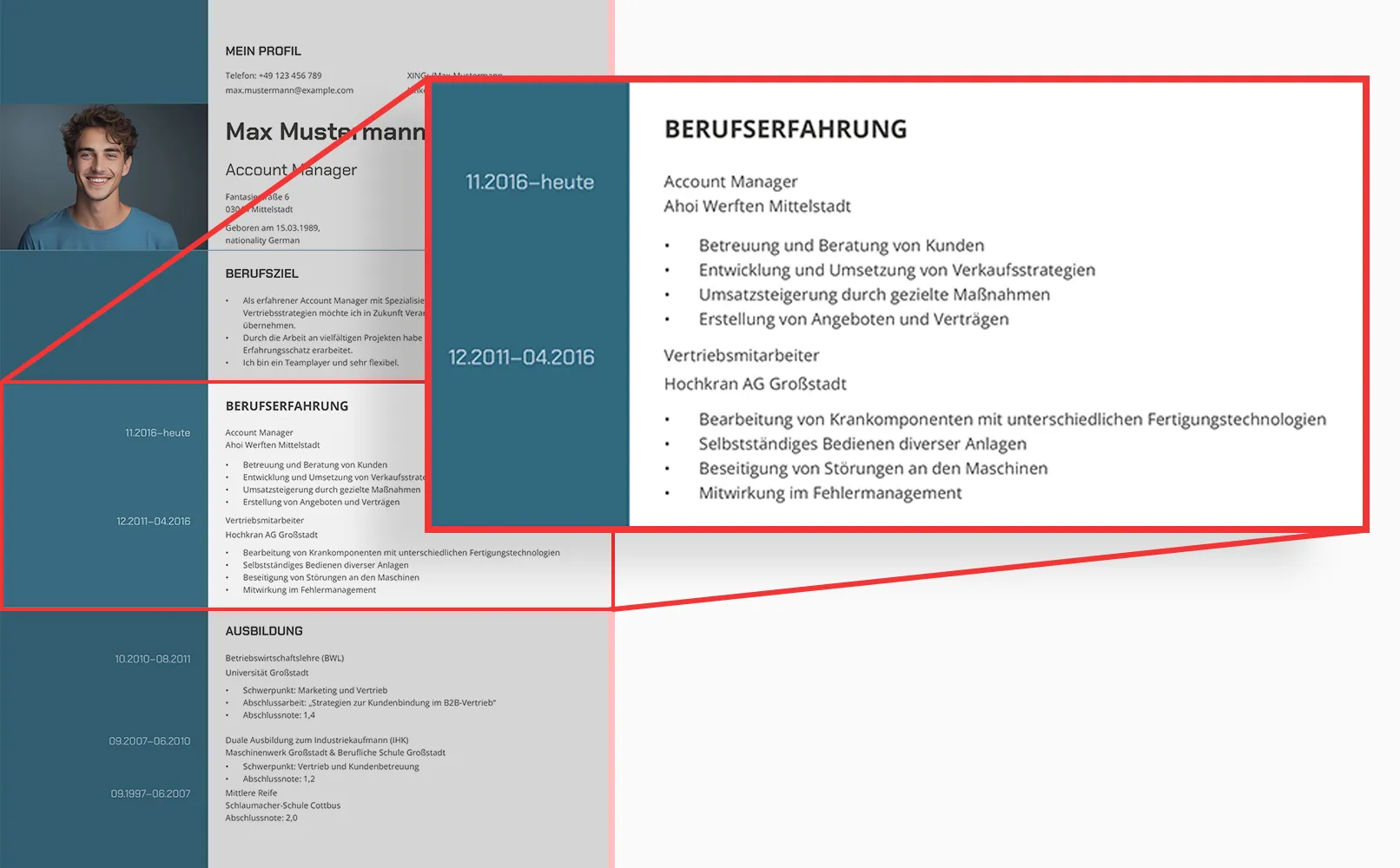
List your previous work positions in reverse chronological order:
- Job Title: Provide the exact title of your position.
- Employer: Mention the company and location.
- Period: Indicate the duration of your employment (Month/Year).
- Tasks and Achievements: Describe your main tasks and special accomplishments in bullet points. Focus on relevant experiences that match the desired position.
When filling out the "Work Experience" section of the CV, it is important to be clear and precise. Start with your most recent or current position and work backward through your work history. Include the name of the company, location, your exact position, and the duration of your employment. Describe your tasks and achievements in short, concise sentences. Emphasize particularly on activities and accomplishments that are relevant to the desired position. Avoid mentioning unimportant or redundant information. Use active verbs and avoid long and complicated sentence structures.
Create your perfect resume with our professional templates! Save time and effort by using our easy-to-use samples. Our templates help you avoid common mistakes and optimize your resume. Click now to purchase your resume template and increase your chances of landing your dream job!
Education in Resume
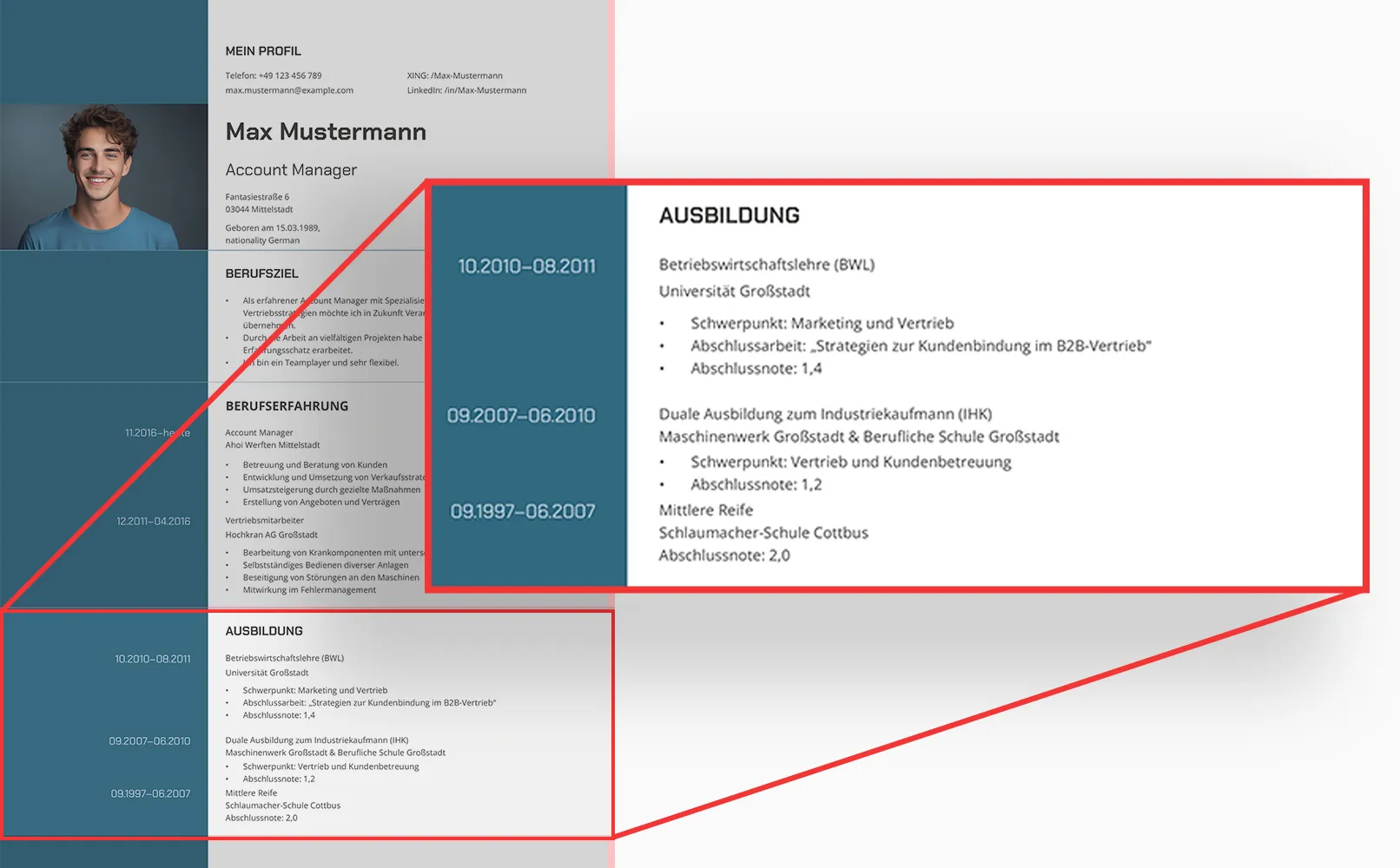
Also here in reverse chronological order:
- Educational Institution: Name and location of the school/university.
- Degree: Type of degree and major.
- Duration: Specify the duration of your studies (month/year).
- Special Achievements: Mention relevant projects, theses, or special awards.
When filling out the "Education" section in your resume, it is crucial to clearly and concisely present your educational background. Start with your highest educational qualification and work backwards through your academic experiences. Include the name of the institution, location, exact degree, and duration of study. Mention any special awards or outstanding achievements that highlight your qualifications. If relevant, also add important projects or research experiences. Be sure not to include irrelevant information.
Skills and Competencies in Resume
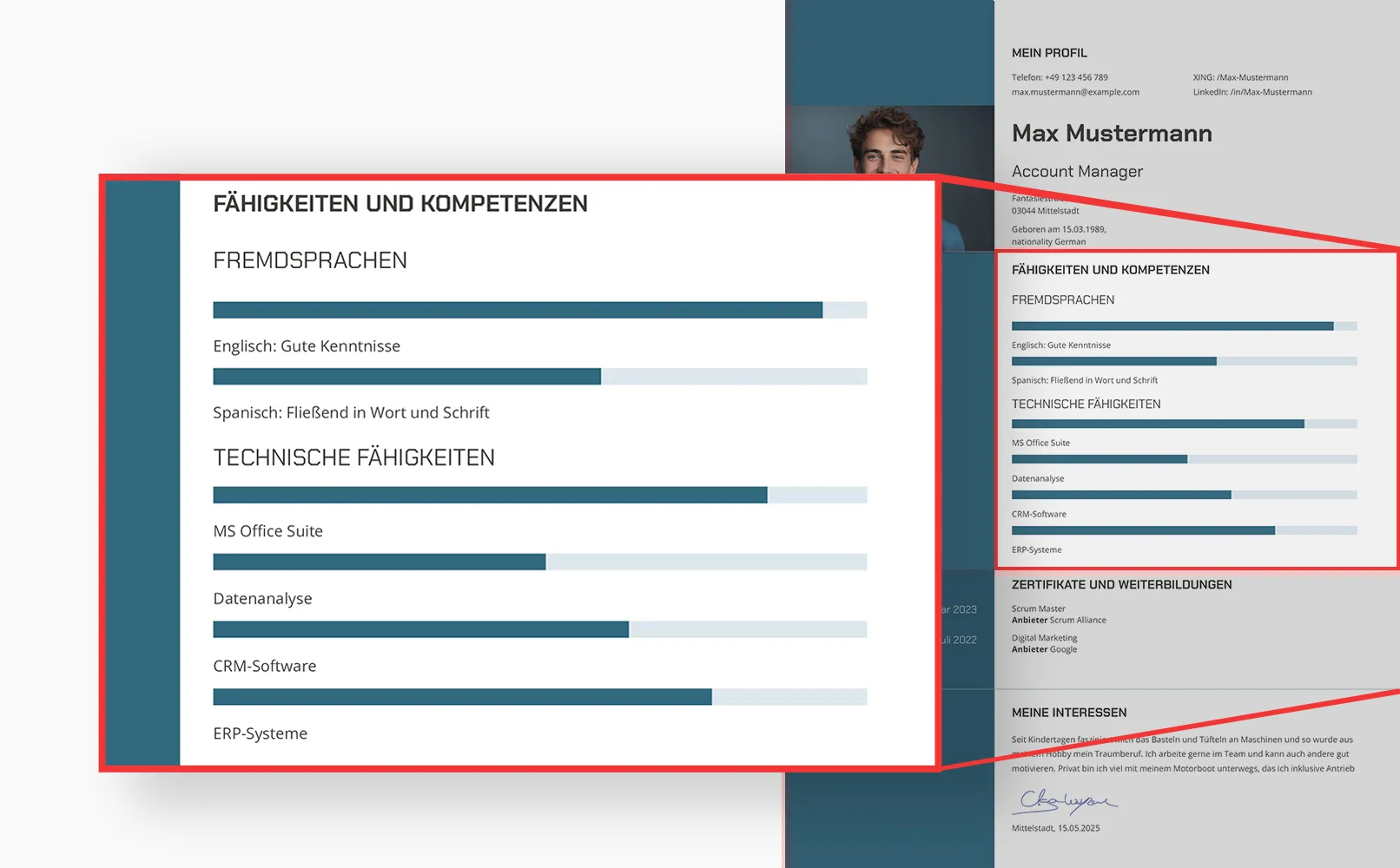
List your relevant skills:
- Technical Skills: Proficiency in specific programs, tools, or technologies.
- Language Skills: Languages and their proficiency level (e.g., native language, fluent, basic).
- Social Competencies: Teamwork, communication skills, leadership qualities. Focus on skills relevant to the desired position.
When filling out the "Skills and Competencies" section in your resume, focus on relevant and specific skills that qualify you for the desired position. Mention both technical and interpersonal skills. Technical skills may include programming knowledge, software proficiency, or specialized expertise. Interpersonal skills could be communication skills, teamwork, or problem-solving abilities. Use precise language and avoid general or vague statements.
Success requires two things: Clear goals and the burning desire to achieve them.
Johann Wolfgang von Goethe
Certificates and Further Education in Resume
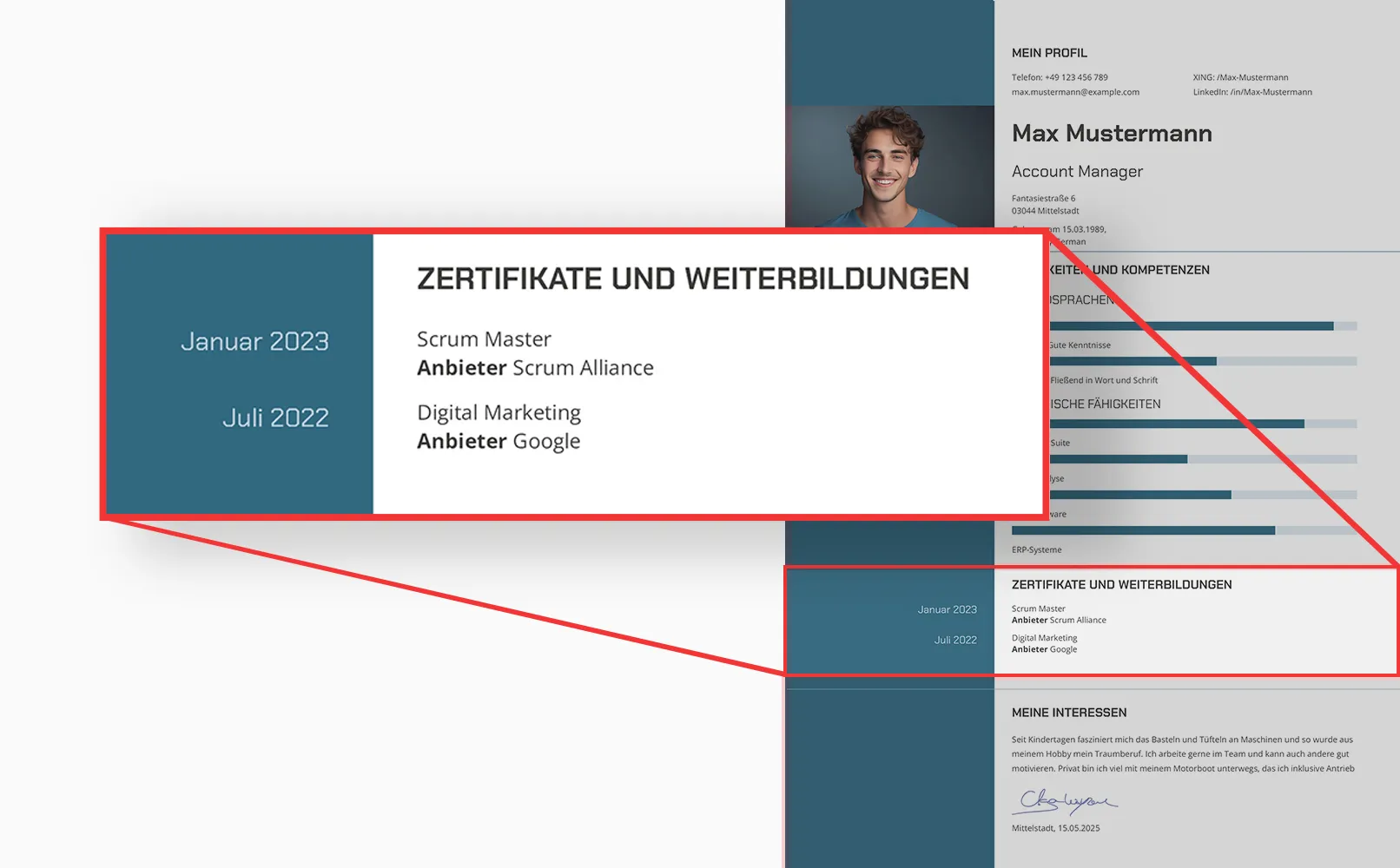
Mention all relevant certificates and further education:
- Title of Certificate/Further Education: Specify the exact title.
- Institution: Name the institution or company that offered the further education.
- Date: Provide the year or period of the further education.
When filling out the "Further Education" section in your resume, list all relevant continuing education and further training that enhance your professional skills and qualifications. Start with the most recent further education and work backwards through your educational history. Include the title of the further education, the provider, location (if applicable), and the date or duration. Briefly describe the content or objectives of the further education, especially if they are relevant to the desired position. Highlight any special certificates or degrees you obtained through these further education programs.
We don't insist that you purchase our resume templates, but we just want to point out that with them, you will find a job more quickly.
Hobbies and Interests in Resume
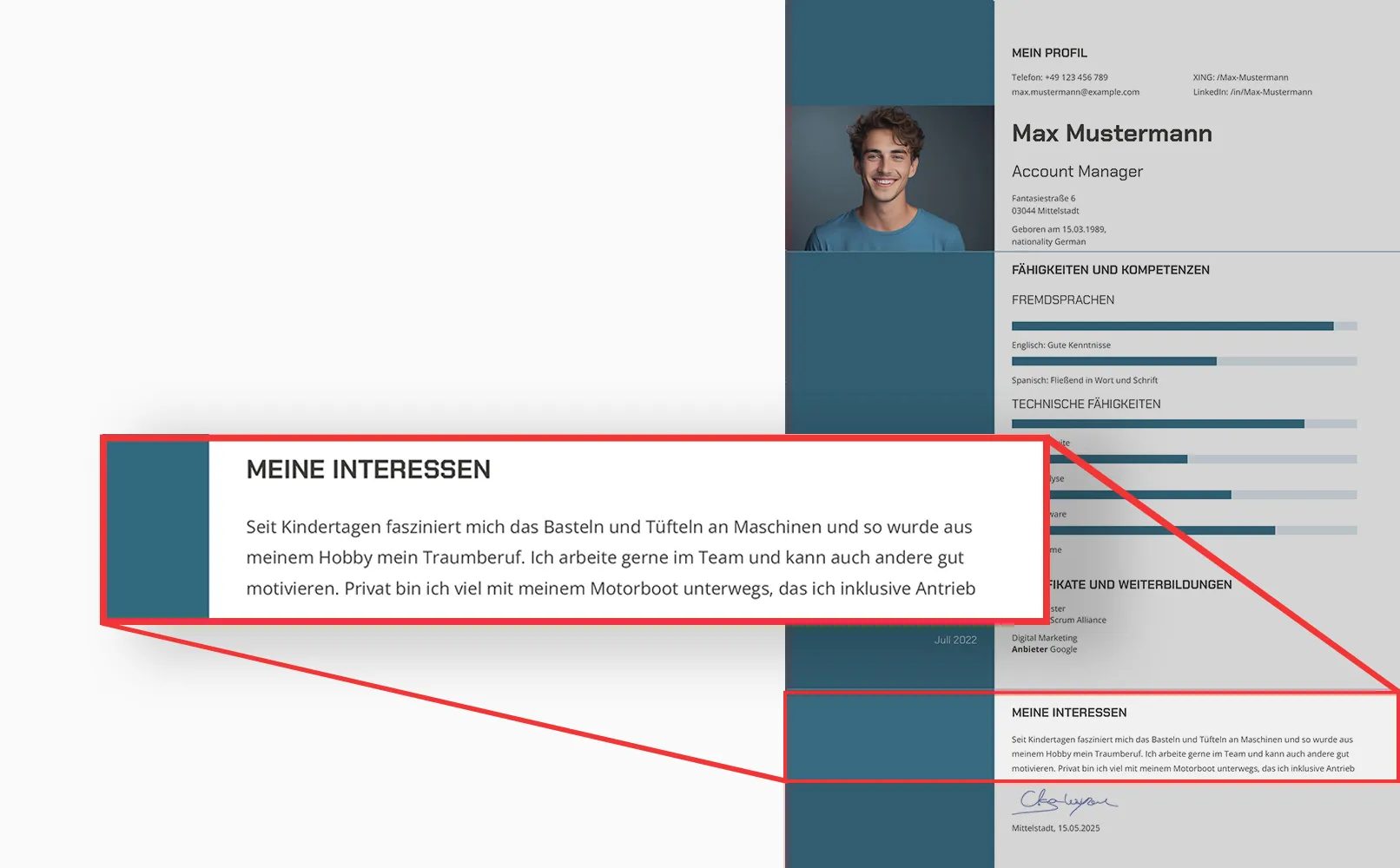
Mention only hobbies and interests that are relevant to the position or that highlight special skills and traits:
- Relevant Hobbies: E.g., team sports that demonstrate teamwork, or programming projects that illustrate technical interest. Also good are triathlons, strength training, or marathons, as they transparently showcase discipline as a habit.
- Special Interests: Volunteer activities or memberships in professional associations.
When filling out the section "Hobbies and Interests" in your resume, it's wise to mention activities that present you in a positive light and may be relevant to the desired position. Choose hobbies and interests that highlight your personality and additional skills. Sports activities can demonstrate teamwork and perseverance, while creative hobbies like painting or writing can emphasize your creativity and attention to detail. Are you involved in volunteer work or clubs? This can highlight your social engagement and leadership qualities. Make sure this section remains short and concise. A careful selection and presentation of your hobbies and interests can round out your profile and leave a positive impression on potential employers.
Classic and Modern Templates for Resume and Application on TutKit.com
On our portal TutKit.com, you will find a wide selection of classic and modern templates for your resume and application. Our templates are designed to make your application process easier and to help you present yourself professionally and appealingly.
A powerful flame arises from a tiny spark.
Dante Alighieri
Free Downloadable Template
We offer you a free downloadable template so that you can convince yourself of the structure and quality of our templates. To receive this free template, we ask you to first browse through our range of templates. This way, you can ensure that you make the best choice for your application.
All our templates are available in Adobe InDesign, Microsoft Word, and Serif Affinity Publisher formats. They remain in your possession forever, and you can edit them infinitely to suit your needs. After editing, you can save the files in the desired format, such as PDF. Follow the link to go to the page with the instructions for PDF saving and download the complete template package for free.
FAQs: 25 Common Questions about Resumes and Answers
1. What should I do if I have frequently changed jobs and had 10 positions in 5 years?
Explain in the cover letter or during the interview why you have changed jobs frequently. Emphasize the positive aspects, such as diverse experiences and acquired skills. Show that you are now seeking stability and are ready to commit long term.
2. What should I do if I am looking for my first job and can hardly write anything in the resume besides education?
Concentrate on relevant projects, internships, and volunteer work. Highlight skills and knowledge acquired during your studies. Mention soft skills like teamwork, problem-solving, and organization.
3. What happens if I lie and how can employers verify my information?
Lies in the resume can have serious consequences, including termination and damage to your reputation. Employers can verify references, request certificates, or verify your information through networks like LinkedIn. Stay honest and authentic.
4. How long does it usually take to receive a response after submitting an application?
Typically, it takes about two to four weeks to receive a response. If you haven't heard anything after two weeks, you can politely inquire about the status of your application.
5. Structural Question: How long should my resume be?
One to two pages is ideal. Keep the information concise and focus on the essentials.
6. Should I add a photo?
Yes, a professional photo is common and often expected in Germany.
7. What font and size should I use?
Use a legible font like Roboto, Ubuntu, Lato, or Montserrat in sizes 10-12. Headings can be slightly larger. Avoid fonts that make you look generic like Arial, Times New Roman, or Calibri.
8. Should I list all the jobs I've ever had?
Give more space in your resume to the relevant positions that are important for the desired position. Avoid creating large gaps in your resume.
9. How detailed should my descriptions be?
Describe tasks and achievements in bullet points. Focus on relevant and significant points.
10. How should I address gaps in my resume?
Explain larger gaps honestly, for example, due to further education, travels, or personal projects.
11. Should I mention my hobbies?
Only if they are relevant to the position or highlight particular skills.
12. How important are further education and certificates?
Very important, especially if they are relevant to the desired position.
13. How do I formulate my career objective?
Be brief and concise. Describe the position you aspire to and how it fits into your career plan.
14. Should I mention my salary expectations in the resume?
No, salary expectations belong in the cover letter or will be discussed during the interview.
15. Can I submit the application in English?
Only if it is explicitly required. In Germany, a German resume is generally expected.
16. How do I address frequent job changes?
Highlight relevant experiences and acquired skills. Explain changes if necessary in the cover letter.
17. Should I include references in the application?
Only if explicitly requested. Otherwise, you can state "References available upon request" or refer to them via a link. In some technical professions, include a project list as an attachment.
18. How should I describe my language skills?
Indicate the level (e.g., native language, fluent, basic knowledge). Use recognized standards like the Common European Framework of Reference for Languages (A1-C2).
19. Should I detail my school education?
Mention only the highest completed school education and relevant qualifications.
20. How do I handle temporary employment?
Specify the period and position. Explain in the cover letter why it was a temporary position.
21. Can I creatively design my application?
Yes, but ensure it remains clear and professional. Creative elements should support the content, not dominate it.
22. Should I include volunteer activities?
Yes, especially if they highlight relevant skills or qualities.
23. How can I best update my resume?
Immediately add new experiences and qualifications. Regularly revise the entire resume and tailor it to the desired position.
24. How important are social skills in the resume?
Very important. Highlight skills such as teamwork, communication, and leadership, especially if they are relevant to the position.
25. How can I take a professional photo myself?
- Background: Choose a neutral, bright background without distractions.
- Lighting: Use natural light or multiple light sources to avoid shadows.
- Clothing: Wear professional attire appropriate for the desired position.
- Camera: Use a high-quality camera or a good smartphone.
- Position: Face the camera directly and ensure your head and shoulders are fully visible.
- Editing: Lightly edit the photo to correct colors and optimize the background, but avoid overdoing it.
Note: On our platform, there is a detailed step-by-step guide on how to create a professional application photo at home.
From Vitalii Shynakov
